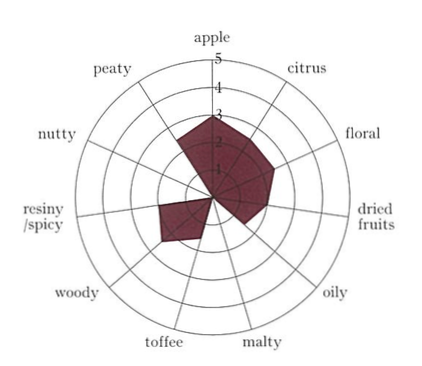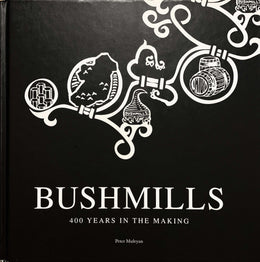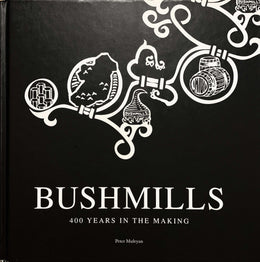The Macallan - The Malt: Easter Elchies House: Spiritual home of The Macallan; “The Definitive Guide To Buying Vintage Macallan”

It is said that, in John Grant's grandfather's day, a Covenanting army had plundered the Palace of Elchies', and the old charters tell us that the lands of 'Easter Elloquy or Elchies' were granted to the Captain's great-grandfather's great-grandfather by the Bishop of Moray in January 1543.
Captain John Grant of Elchies is credited with having built Easter Elchies House in 1700. This is based on a carved datestone above the door, but the original house on the site—beautifully situated, in an elevated position on the left bank of the Spey—may be a century older. It is said that, in John Grant's grandfather's day, a Covenanting army had plundered the Palace of Elchies', and the old charters tell us that the lands of 'Easter Elloquy or Elchies' were granted to the father by the Bishop of Moray in January 1543.
Captain John supported King William's cause following the abdication of King James II and IV in 1689, and when General Buchan arrived in Speyside from the West with the Jacobite Highland Host in April 1690, on his way to ravage Elgin and Aberdeen, he was in command of the Grant stronghold of Ballachastell, some three miles east and north of Grantown-on-Spey. Before dawn on 1st May, Sir Thomas Livingstone, King William's general in the north, arrived with 800 foot-soldiers and 400 cavalry. Grant immediately led them across the Spey and, with the Grants riding pillion on the cavalry horses, they surprised the Highlanders and drove them over the Haughs of Cromdale. No less an authority than Sir Walter Scott tells us that Captain Grant himself "killed with his own hand two of the Highlanders, outposts or sentinels".
A monument to him stands in the burial aisle of the church at Easter Elchies, erected by his son, Patrick, who now became the laird. Having studied at the universities of Aberdeen and Leiden, Patrick was a highly successful Advocate, and in 1732 was elevated to the bench, a Senator of the College of Justice, with the title Lord Elchies. Like his father he was a staunch Whig, and as a result had his residence near Edinburgh occupied by Highland troops in 1745, when Bonnie Prince Charlie held court in the capital. Easter Elchies was also ransacked at this time, where, as he wrote to a friend, "the rebells [sic] had left nothing but the bare walls, but had destroyed ey'rything [sic] they could not carry with them".
Lord Elchies died in 1754 and was succeeded by his son, John, who was also a Whig and a lawyer, being created a Baron of Exchequer the year after his father's death. He married the daughter of Lord Milton, one of the most powerful men in Scotland and the 'sub-minister' for the Duke of Argyll and his brother the Earl of Islay—the men who effectively governed the country from London during the middle decades of the eighteenth century Not long after he inherited Easter Elchies he sold the estate to the Earl of Findlater and Seafield. Exactly fifty years later (1811) these titles passed to Sir Lewis Grant of Grant, kinsman of the Grants of Easter Elchies, so the old House of Easter Elchies was once more brought into the ownership of its founding family The Seafield seat was Castle Grant, a mere 18 miles away — a place which was once famous for its parties. A visitor in the 1780s recalled:

"There had been a carousing party at Castle Grant, and as the evening advanced towards morning, two Highlanders were in attendance to carry the guests upstairs —it being understood that none could by any other means arrive at their sleeping apartments. One or two of the guests, whether from their abstinence or their superior strength o f head, were walking upstairs, and declined the proffered assistance. The attendants were astonished, and indignantly exclaimed, "Ach, it's sare cheenged times at Castle Grant, when gentlemen can gang to bed on their ain feet!"
While these high jinks were going on down the road, the records are silent about who was living in the old House of Easter Elchies, until 1820 that is, the year the house and farm were rented from Lord Seafield by Alexander Reid, a man "well known locally for applying the most advanced methods of farming". Four years later, and with the full support of the laird, Reid established the first licenced distillery on the site — named 'Macallan, after the ancient and ruinous church which stands close by, and the former name of the parish.
By the time he died in 1847, Alexander Reid had established a reputation for the 'superior quality' of his whisky. The little distillery community comprised: himself, his wife and two children, living in Easter Elchies House; a resident excise man, Donald Robertson, and seven 'servants', who worked both the farm and the distillery, according to the season—distilling being a winter occupation. Alexander's twenty-two year old son followed him to the grave the following year, and the lease for Macallan Distillery was taken over by James Shearer Priest and James Davidson.
Their partnership was to last only four years, after which Davidson ran the business himself. A contemporary newspaper describes him as a man 'of great energy and spirit, and the amount of work he went through from year to year with his own unaided hand seems incredible. He kept no manager, clerk or traveller, and when we find that his sales were principally to customers all over the North, and that he combined all these offices himself, we have no doubt our readers will believe us that he possessed endurance, method and business capacities in a very high degree.'

"Distillers generally purchase only the common variety of barley, but since '57 - '58 [Davidson was] in the habit of purchasing the finest grain, finding, as he often said, that with management, the finer material the better produce."
In 1857, the Earl of Seafield considerably repaired and extended the ancient pile: what had been a simple L -plan tower house became a T -plan mansion with twenty-nine rooms, "three stories high, with a slated turret and dome". We do not know why the refurbishment took place at this time, but we do know
"Comparisons are sometimes made between single malt whiskies and the great houses of Bordeaux. Both are the product of a single unit; both take their name from the place in which they are located; both are the outcome of craftsmanship, care and time; but until now, the Chateaux of Bordeaux had a single advantage, their chateaux......We now have Easter Elchies."ALLAN SHIACH | Former Chairman of Macallan-Glenlived plc.
that soon after it was leased by a retired army officer, by name of Grant—perhaps a relation of Lord Seafield. Somewhat mysteriously, the census of 1861 reveals that it housed his two children (aged four and two years), a housekeeper and lady's maid, a cook, a nurse, a housemaid, a laundry-maid and a table-maid. But there is no mention of Mr. Grant himself, or his wife, and the following year the house was leased by the Earl of Elgin as a shooting box.
The Earl, his family and guests arrived in August each year to shoot grouse and probably stayed on until October — to shoot partridges and pheasants on ask the low ground, stalk stags in the high hills and fish for salmon on the estate's excellent beat, just below the house.
It was while he was on the moor, in the summer of 1893, that the 9th Earl of Elgin received the news that the Government wished to appoint him Viceroy of India. He accepted the news gladly and was about to proceed to the next drive when the messenger respectfully suggested that a reply was required. His Lordship laughed and asked how he could possibly send an immediate reply when he was in the middle of a Scottish grouse moor, but the messenger had had the foresight to bring with him the necessary forms for a speedy telegraphic answer, and thereafter his annual visits were terminated by more important business.
Never slow to miss an opportunity, Roderick Kemp, the owner of the distillery at the time, quickly sent his 'neighbourly' congratulations, adding,

"Fine Old Highland Whisky is now much used and appreciated in India by the better class of Europeans. I have an old standing connection there, and I shall be pleased to send out for your Lordship some of the real old "Macallan'".
Nothing much is known about the fortunes of the grand old house during the following sixty-five years, but by the late 1960s it was in such poor condition that there was a move to demolish it. Mercifully, Peter Shiach, a direct descendant of Roderick Kemp and a director of Macallan-Glenlivet plc., was keen to restore it and make it his family home.
In 1969 he opened negotiations with Seafield Estates, but these seem to have broken down by 1971, when a minute of a Board meeting intimates that "he was no longer interested in leasing the property", although " it was agreed that no steps be taken to demolish the property,but that arrangements be made to wire it off meantime in order to minimise the possibility of trespassers entering and damaging the property".
Was he playing a waiting game? Certainly the early 1970s were a bad time for the Scotch whisky industry—one of Macallan's directors described it as "the worst down-turn in the distillery's history" — but by 1978 things were looking brighter, and again the directors' attention turned to Easter Elchies House.
A feasibility study was commissioned from Michael Laird and Partners, architects in Edinburgh, with regard to restoring and reconstructing the house for office accommodation and entertainment facilities. They estimated a cost of £150,000,and the Boardagreed to Phase 1, which involved structural restoration, drainage, installing electricity and clearing the adjacent site.
Work began in 1981 and by the time it was finished, in September 1985, had cost around half a million pounds. The additions of 1857 were removed and the remaining walls restored and re-harled. The roof was rebuilt and re-slated. Two stone dormer windows were renewed and new stairs installed. Sash and case windows were fitted throughout, as were cast iron water pipes. The old architrave, skirting and cornice designs were re-used. All the fittings and furnishings were carefully selected by Michael Laird to help maintain the ambience of the house.


1940 I A frenetic Mickey Mouse appeared in Walt Disney's epic "Fantasia". The Disney character subsequently appeared in World War II training films for American troops across the world—making him a global phenomenon. Meanwhile, 4 French teenagers followed their inquisitive dog down a hole only to discover the 17,000-year-old Lascaux Cave Paintings.
|
ORIGIN |
Acquired in bottle from a private collection. |
|
NOSE |
Heavy burnt peat dominates the nose with dried fruits and vanilla toffee notes breaking through on second nosing. Some hints of lighter and citrus fruits with a late floral nose. |
|
PALATE |
Peaty with some dried fruits and nuts with a late and sweetening toffee character. |
|
FINISH |
Wood maturity is enhanced with peat smoke to linger for a long and dry finish. |
|
STRENGTH |
43% Vol. |
|
COLOUR |
Oak |
|
TINT |
22 |
|
YEAR BOTTLED |
First bottled in 1975
|
|
AGE OF WHISKY |
35 Years Old
|
|
DISTILLERY PRICE |
|
|
BOTTLE SIZE 700ml |
£2,575 |
|
BOTTLE SIZE 750ml |
£2,760 |
|
BOTTLE SIZE 50ml |
£220 |
|
TOTAL OUTTURN |
|
|
420 Bottle Equivalents |
|


1940 I Literary giant Ernest Hemingway wrote 'For Whom the Bell Tolls', which drew on Hemingway's experiences as a correspondent covering the Spanish civil war Karl K. Pabst of the Bantam Car. Co., Butler, Pennsylvania, produced a four-wheel drive vehicle which became famous as the Jeep. I t was given its name by its military designation, G.P. ("General Purpose").
|
ORIGIN |
Acquired in bottle from a private collection. |
|
NOSE |
Fruity esters, perfumed and forward. Light oiliness apparent with tangy citrus of lemons and limes. |
|
PALATE |
Complex mix of tangy citrus fruits, spiced wood and robust peat smoke. |
|
FINISH |
Citrus, peat, spices and wood—long, long, long finish. |
|
STRENGTH |
43% Vol. |
|
COLOUR |
Oak |
|
TINT |
21 |
|
YEAR BOTTLED |
First bottled in 1977 |
|
AGE OF WHISKY |
37 Years Old |
|
DISTILLERY PRICE |
|
|
BOTTLE SIZE 700ml |
£2,800 |
|
BOTTLE SIZE 750ml |
£3000 |
|
BOTTLE SIZE 50ml |
£235 |
|
TOTAL OUTTURN |
|
|
132 Bottle Equivalents |
|


1945 I World War II ended; The United Nations was established at a San Francisco conference, holding its first meeting the following year. The first ball-point pen was sold by Gimbell's department store in New York for a price of $12, and the first "bug" in a computer programme was discovered by Grace Hopper when a moth was removed with tweezers from a relay and taped into the log.
|
CASK TYPE |
Married Hogsheads |
|
CASK No |
46/3M |
|
NOSE |
Rich lemon citrus nose with strong peat smoke. Hints of ginger spices and apple fruits. |
|
PALATE |
Good lemon with mature wood and strong peat smoke. |
|
FINISH |
Lingering peats and woodsmoke |
|
STRENGTH |
44.3% Vol. |
|
COLOR |
Rich Beech |
|
TINT |
18 |
|
YEAR BOTTLED |
2002 |
|
AGE OF WHISKY |
56 Years Old |
|
DISTILLERY PRICE |
|
|
BOTTLE SIZE 700ml |
£2,250 |
|
BOTTLE SIZE 750ml |
£2,410 |
|
BOTTLE SIZE 50ml |
£195 |
|
TOTAL OUTTURN |
|
|
350 Bottle Equivalents |
|


1948 I The world began to value convenience and technology this year, as both the tape recorder and Polaroid" camera went on sale. The invention of the transistor was to be the precursor of miniaturisation in science and technology 36-year-old painter Jackson Pollock painted Composition No 1 (tachisma), bolstering Abstract Expressionism.
|
CASK TYPE |
Hogsheads |
|
CASK No |
609 |
|
NOSE |
Soft peat, lemon citrus and appley. Honey sweetness and balanced wood note. |
|
PALATE |
Floral, light fruits with a lightly burnt peat smoke.
|
|
FINISH |
Excellent peat and light fruit balance. |
|
STRENGTH |
45.3% Vol. |
|
COLOR |
Rich Oak |
|
TINT |
25 |
|
YEAR BOTTLED |
2002 |
|
AGE OF WHISKY |
53 Years Old |
|
DISTILLERY PRICE |
|
|
BOTTLE SIZE 700ml |
£2,475 |
|
BOTTLE SIZE 750ml |
£2,660 |
|
BOTTLE SIZE 50ml |
£195 |
|
TOTAL OUTTURN |
|
|
124 Bottle Equivalents |
|


1949 I The first non-stop flight around the world was completed by Captain James Gallagher of the US Air Force, and his crew of 14, in an aircraft called `Lucky Lady II'. Arthur Miller's play 'Death of a Salesman' won the Pulitzer Prize and Mao Zedong became the first chairman of the People's Republic of China with the ending of the Chinese civil war
|
CASK TYPE |
Hogsheads |
|
CASK No |
136 |
|
NOSE |
Tropical fruit (pineapple) with some dried fruit raisins Light wood and peat. |
|
PALATE |
Pineapple and other fruits with light cinnamon spices and peat. |
|
FINISH |
Tropical fruit sweetness balanced with drying peat smoke. |
|
STRENGTH |
49.8% Vol. |
|
COLOR |
Rich Oak |
|
TINT |
26 |
|
YEAR BOTTLED |
2002 |
|
AGE OF WHISKY |
53 Years Old |
|
DISTILLERY PRICE |
|
|
BOTTLE SIZE 700ml |
£2,250 |
|
BOTTLE SIZE 750ml |
£2,410 |
|
BOTTLE SIZE 50ml |
£195 |
|
TOTAL OUTTURN |
|
|
160 Bottle Equivalents |
|


1949 I A 31-year-old evangelical preacher from North Carolina named Billy Graham gained national attention in the US with a number of noteworthy celebrity conversions during his Los Angeles crusade. Almost four years after the end of World War II, clothes rationing in Great Britain ended, whilst Germany was divided into two nations, East and West Germany.
|
CASK TYPE |
Hogsheads |
|
CASK No |
935 |
|
NOSE |
Tropical and citrus fruits hill? peaty Islay-like notes. |
|
PALATE |
Fruity, peaty with light vanilla toffee. Hints of wood and spice. |
|
FINISH |
Complex fruits and peaty dryness. Light malted cereal. |
|
STRENGTH |
41.1% Vol. |
|
COLOR |
Rich Rosewood |
|
TINT |
45 |
|
YEAR BOTTLED |
2002 |
|
AGE OF WHISKY |
52 Years Old |
|
DISTILLERY PRICE |
|
|
BOTTLE SIZE 700ml |
£2,100 |
|
BOTTLE SIZE 750ml |
£2,250 |
|
BOTTLE SIZE 50ml |
£185 |
|
TOTAL OUTTURN |
|
|
228 Bottle Equivalents |
|
"The Macallan is quite probably the finest malt in the world... its other undeniable quality is its capacity to disappear with speed."ROBERT McCALL | Author of ‘500 Years of Scotch Whisky’"The Macallan was and is a masterpiece of impressive fullness and complexity"STEFAN GABANYI | Author of ‘Whisk(e)y’
Written by Charles MacLean
The text is an excerpt from "The Definitive Guide to Buying Vintage Macallan" (pp. 42 - 55), First Edition, published 2003 by Macallan Distillery Ltd.







